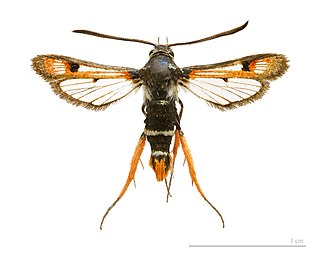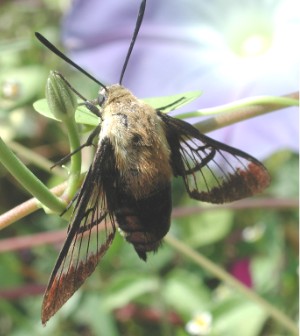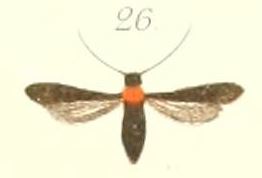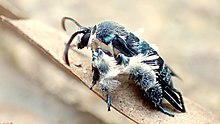
The Sesiidae or clearwing moths are a diurnal moth family in the order Lepidoptera known for their Batesian mimicry in both appearance and behaviour of various Hymenoptera.

Sesioidea is a superfamily containing clearwing moths (Sesiidae), castniid moths (Castniidae) and little bear moths (Brachodidae). There is evidence from head and thoracic morphology that the first two families, internally feeding in plants as caterpillars, are sisters, whilst some brachodids are known to feed on leaf surfaces. Sesioidea is closely related to Cossoidea, which contains the also internal-feeding Goat and Leopard moths, and recent taxonomic treatments consider the sessoid families as part of Cossoidea sensu lato.

Hemaris is a genus of sphinx moths in the subfamily Macroglossinae, which is native to the Holarctic. Their main host plants are herbs and shrubs of the teasel and honeysuckle families. Moths in genus Hemaris are known collectively as clearwing moths or hummingbird moths in the US and Canada and bee hawk-moths in Britain. The related Old World hummingbird hawk-moths, genus Macroglossum, are similar in appearance and habits. Both genera have tails that are provided with an expansile truncated tuft of hairs, but only Hemaris has the disc of the wings transparent, as these scales are dropped soon after eclosion.

Brachodidae is a family of day-flying moths, commonly known as little bear moths, which contains about 135 species distributed around much of the world. The relationships and status of the presently included genera are not well understood.

Paranthrene tabaniformis, the dusky clearwing, is a moth of the family Sesiidae. It is found in the Palearctic and Nearctic realms.
Ichneumenoptera commoni is a moth of the family Sesiidae which was described by W. Donald Duckworth and Thomas Drake Eichlin in 1974. It is known only from the male type which was collected near Toowoomba in Queensland, Australia.

Bembecia ichneumoniformis, the six-belted clearwing, is a moth of the family Sesiidae.
Oligophlebia is a genus of moths in the family Sesiidae, the clearwing moths. They are native to the Palearctic realm.
Aschistophleps is a genus of moths in the family Sesiidae.

Heterosphecia is a genus of moths in the family Sesiidae which is found from Borneo, Sumatra and South India. There are eight known species with few records, so consequently their conservation status is unknown.
Stenosphecia is a monotypic genus of moths in the family Sesiidae. Its sole species is Stenosphecia columbica. Both genus and species were described in 1917 by Ferdinand Le Cerf. It is found in the Neotropical realm.
Carmenta texana, the Texana clearwing moth, is a moth of the family Sesiidae. It was described by Henry Edwards in 1881 and is known from the US states of Texas and Florida.
Carmenta laurelae is a moth of the family Sesiidae. It was described by Larry N. Brown, Thomas D. Eichlin and J. Wendell Snow in 1985, and is known from the US state of Florida.

Synanthedon formicaeformis, the red-tipped clearwing, is a moth of the family Sesiidae and can be found in all of Europe, the eastern Palearctic realm, and the Near East. The larvae sometimes form pear-shaped galls on willows. It was first described by Eugenius Johann Christoph Esper in 1783.
Synanthedon flaviventris, the sallow clearwing, is a moth of the family Sesiidae. The larvae form pear-shaped galls on sallows.
William Warren was an English entomologist who specialised in Lepidoptera.

Trilochana scolioides is a moth of the family Sesiidae. It is found in India (Darjeeling), Thailand and Vietnam.

Teinotarsina aurantiaca is a moth of the family Sesiidae. It is known from Japan (Okinawa-jima).

Albuna pyramidalis, the fireweed clearwing moth, is a species of clearwing moth in the family Sesiidae.

The Tinthiinae are a subfamily of clearwing moths, first established in 1917 by Ferdinand Le Cerf.











